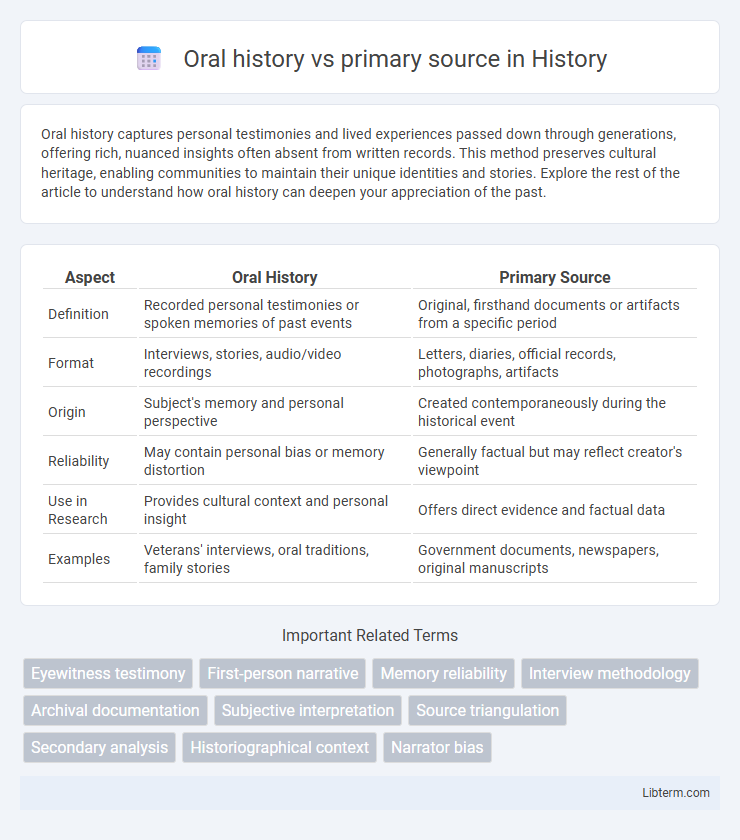Oral history captures personal testimonies and lived experiences passed down through generations, offering rich, nuanced insights often absent from written records. This method preserves cultural heritage, enabling communities to maintain their unique identities and stories. Explore the rest of the article to understand how oral history can deepen your appreciation of the past.
Table of Comparison
| Aspect | Oral History | Primary Source |
|---|---|---|
| Definition | Recorded personal testimonies or spoken memories of past events | Original, firsthand documents or artifacts from a specific period |
| Format | Interviews, stories, audio/video recordings | Letters, diaries, official records, photographs, artifacts |
| Origin | Subject's memory and personal perspective | Created contemporaneously during the historical event |
| Reliability | May contain personal bias or memory distortion | Generally factual but may reflect creator's viewpoint |
| Use in Research | Provides cultural context and personal insight | Offers direct evidence and factual data |
| Examples | Veterans' interviews, oral traditions, family stories | Government documents, newspapers, original manuscripts |
Defining Oral History and Primary Sources
Oral history is a method of gathering and preserving firsthand testimonies through recorded interviews that capture personal experiences and cultural narratives, often used to document perspectives not found in written records. Primary sources include original documents, artifacts, or other direct evidence from the time period under study, such as letters, diaries, photographs, official records, and oral histories themselves. While oral history is a type of primary source emphasizing spoken memories, primary sources broadly encompass any original materials that provide direct insight into historical events.
Key Differences Between Oral History and Primary Sources
Oral history is a firsthand account recorded through interviews and personal narratives, capturing lived experiences and subjective perspectives. Primary sources include original documents, artifacts, and records created contemporaneously with the event, providing direct evidence without interpretation. Key differences lie in oral history's emphasis on memory and storytelling, while primary sources prioritize concrete, often written, documentation.
The Role of Memory in Oral History
Oral history relies heavily on the role of memory as it captures personal recollections and subjective experiences that are not always documented in traditional primary sources such as official records, letters, or photographs. Memory shapes the narrative in oral history, providing unique insights and context that might be lost in written documents but also introduces challenges related to accuracy and bias. Unlike primary sources that offer contemporaneous evidence, oral histories reflect how individuals remember and interpret past events, highlighting the dynamic and interpretive nature of memory in preserving historical knowledge.
Authenticity and Reliability: Evaluating Both Methods
Oral history offers firsthand accounts that provide rich, personal perspectives but can be subject to memory bias and subjective interpretation, affecting authenticity and reliability. Primary sources, such as official documents or artifacts, generally provide more verifiable and tangible evidence, enhancing credibility. Evaluating both methods requires cross-referencing oral testimonies with primary source data to validate accuracy and build a comprehensive historical understanding.
Contextual Value of Oral Testimonies
Oral history offers unique contextual value by capturing personal experiences and cultural nuances that primary sources like documents and artifacts may lack. These testimonies provide insight into social dynamics, emotions, and perspectives, enriching historical understanding beyond factual data. Researchers rely on oral histories to fill gaps in written records, enhancing the depth and authenticity of historical narratives.
Written Records as Primary Sources
Written records serve as essential primary sources, offering direct evidence about past events through official documents, letters, diaries, and manuscripts. Unlike oral history, which relies on personal memory and narration, written records provide fixed, verifiable accounts that can be analyzed for consistency and authenticity. These documents often form the backbone of historical research, allowing scholars to reconstruct events and understand cultural contexts with greater precision.
Strengths of Oral History in Historical Research
Oral history offers unique strengths in historical research by capturing personal experiences and eyewitness accounts that are often absent from written records, providing rich, qualitative data. It preserves diverse perspectives, especially from marginalized or underrepresented communities, enriching the historical narrative with voices that traditional primary sources might overlook. The adaptability of oral history allows researchers to probe emotions, motivations, and cultural contexts, enhancing the depth and authenticity of historical understanding.
Limitations and Challenges of Oral Testimonies
Oral history presents limitations such as memory distortion, subjective interpretation, and potential biases that affect the accuracy of testimonies compared to traditional primary sources like documents or artifacts. Challenges include verifying the authenticity of narratives, managing inconsistencies, and contextualizing personal recollections within broader historical frameworks. These factors complicate the reliability and scholarly use of oral testimony as definitive evidence in historical research.
Integrating Oral History with Traditional Primary Sources
Integrating oral history with traditional primary sources enhances historical research by providing diverse perspectives and enriching context, especially in capturing personal experiences and cultural nuances often absent from official documents. Oral testimonies complement written records, photographs, and artifacts by adding emotional depth and firsthand accounts, crucial for a comprehensive understanding of events. Combining these sources improves accuracy through cross-verification and broadens the scope of historical narratives.
Choosing the Right Source for Historical Study
Oral history provides personal narratives and firsthand accounts that capture emotions and context often missing from traditional documents. Primary sources, including letters, official records, and artifacts, offer direct evidence from the period under study and establish factual timelines. Selecting the right source depends on research goals: oral histories enrich understanding with subjective experiences while primary sources ensure factual accuracy and chronological structure.
Oral history Infographic

 libterm.com
libterm.com